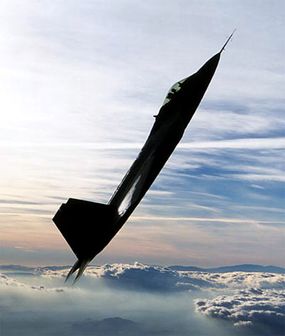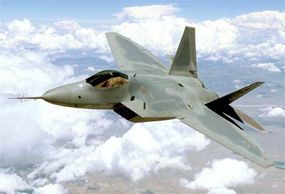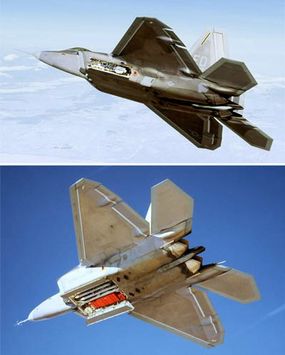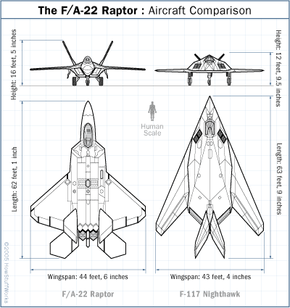Stealth Capability: The Raptor
The F/A-22 incorporates all the lessons learned from previous aircraft. It is so stealthy that it appears to be the size of a bumblebee when detected by radar, even though it is more than 62 feet long and has a wingspan of 44.5 feet.
The angular shape of the F/A-22 is similar to the F-117 Stealth Fighter. Many of the surface shapes are curves with changing radii. These curves scatter radar beams in all directions instead of back to the radar source. There are no right angles on the exterior of the design. Sawtooth edges on cockpit edges, landing gear doors and other openings also break up radar. The edges of the main wing and rear wing line up exactly, making them appear much smaller on radar.
Advertisement

The F/A-22 has two large vertical fins, much like the F-15. On this aircraft, the straight-up fins contribute to a high visibility on radar. On the F/A-22, however, the vertical fins are angled like the body to deflect radar. The fins also conceal internal antennas that help maintain the invisibility of the aircraft.

The F-22's topcoat absorbs radar waves, too, and the cockpit was designed to minimize the radar profile of the pilot's helmet.
Tracking the heat from jet engines is another common way to identify airplanes. Heat-seeking missiles track the infrared emissions from an airplane's engines to find their target. Blocking infrared emissions can fool a heat seeker. In the F/A-22, the horizontal fins at the rear of the aircraft not only make the plane more maneuverable, but they also act as a shield for the engine exhaust heat. Shielding the heat of the engines keeps the thermal or infrared signature of the F/A-22 at a minimum.
Unlike current fighters, the F/A-22 can carry missiles inside the fuselage. The F-15 and F-16, for example, can only carry missiles under the wings, where they can reflect radar waves and make the plane much more visible.

The idea behind all this technology is to reduce the enemy's ability to find, track and target the F/A-22. Pilots can fly into defended areas that would otherwise be inaccessible to American fighters.
Keep reading to find out about the engine that gives the Raptor capabilities never before seen in a fighter jet.
